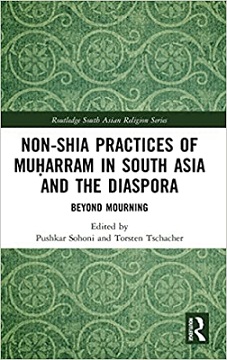Non-Shia Practices of Muḥarram in South Asia and the Diaspora: Beyond Mourning (Routledge South Asian Religion Series)
The book Non-Shia Practices of Muḥarram in South Asia and the Diaspora: Beyond Mourning (Routledge South Asian Religion Series) tries not to reaffirm the merely conventional valency of Muḥarram but to present some of its myriad cultural manifestations and understand its role in mediating political and social identities and tensions.
 | |
| Author | Pushkar Sohoni, Torsten Tschacher |
|---|---|
| Language | English |
| Published | 2021 |
| Publisher | Routledge |
| Pages | 126 |
About the authorsEdit
Pushkar Sohoni is Associate Professor of Humanities and Social Sciences at the Indian Institute of Science Education and Research, Pune. His previous book is The Architecture of a Deccan Sultanate: Courtly Practice and Royal Authority in Late Medieval India (2018).
Torsten Tschacher is a research-scholar at Freie Universität Berlin studying the history and discursive traditions of Muslims around the Bay of Bengal. His book Race, Religion, and the ‘Indian Muslim’ Predicament in Singapore was published in 2018 with Routledge, and he co-edited, with Deepra Dandekar, Islam, Sufism and Everyday Politics of Belonging in South Asia (Routledge 2016).
About the bookEdit
This book published in Routledge; 1st edition (September 27, 2021), has 126 pages.
The chapters by Frank J. Korom and Deepra Dandekar were originally presented as part of a panel on ‘The Decay and Transformation of Non-sectarian Muharram,’ organized by Torsten Tschacher as part of the 45th Annual Conference on South Asia, University of Wisconsin-Madison, in 2016.
Abstract of chaptersEdit
Chapter 1: IntroductionEdit
Pushkar Sohoni and Torsten Tschacher
This part shows that this book focuses on non-Shia practices of Muḥarram celebrations in the past and present: in South Asia and within a larger diaspora and tries to discuss the importance of Muḥarram celebrations in terms of their respective actors by bringing together a variety of regional perspectives (the Deccan, the Punjab, Singapore, South Africa, and Trinidad and Tobago) and linguistic backgrounds (Bhojpuri, Gujarati, Marathi, Punjabi, Tamil, Urdu).
Chapter 2: Ḥusayn’s Hindu DefendersEdit
The rituals, processional display, and the familiar accounts describe the pitiable bravery, the martyrdom of Ḥusayn’s six-month-old son and the defiant courage of Zaynab. These and other episodes demonstrating the heroism and pathos inherent in the Karbala tragedy make its commemoration distinctive. Lyons in this chapter takes a closer look at the mechanisms the group employed to consolidate its identity, including strategic use of British institutions and decrees, and the ways these choices have influenced more than 200 years of caste history. He also explores the fascination other groups have shown for the eminently successful Mohyāls, leading to imitation of their improbable claims.
Chapter 3: An Ethnographic Exploration of Muharram(s) in Pune, MaharashtraEdit
This chapter focuses on Muḥarram celebrations in Pune (Maharashtra), where the festival cannot be viewed as entirely Shia or Sunni, or even exclusively Muslim, with many Hindus participating in the festivities. The author believes that Muḥarram can be characterized as a politically meaningful, polyvalent socioreligious festival, especially in regions defined by a Hindu majority population, acquiring various significations to its celebration(s) on Ashura, the tenth day of the month.
Chapter 4: Visual Language of Piety and Power: Ta’ziahs and Temples in the Western DeccanEdit
Pushkar Sohoni
The author in this chapter shows that as with nineteenth-century Muḥarram processions, our understanding of the tā’ziahs can bear ambivalent emotions: of mourning and celebration – for a lost shared tradition. He also shows that tā’ziahs in the nineteenth-century Western Deccan could well be only an example of a much larger pattern: like so many aspects of Islam, the procession and its physical manifestations reflected the societies and customs in which they were located.
Chapter 5: The Idea of Religion and the Criminalization of Muharram in the Straits Settlements, 1830-1870Edit
Torsten Tschacher
The aim of this chapter is to question the received narrative of successive ‘criminalization’ or ‘politicization’ of Muḥarram in the Straits by looking afresh at available sources concerning the celebration of the festival prior to its suppression in the 1860s, such as newspaper reports and government records. The author’s main argument is that Muḥarram and similar non-Christian public festivals and ritual performances became central to a new discourse on ‘religion’ among colonial elites in the Straits Settlements.
Chapter 6: Contestation and Transformation: Muharram Practices among Sunni Muslims in South Africa, 1860-2020Edit
This chapter examines the debate over, and transformation of, Muḥarram practices among Indian Muslims in South Africa with particular reference to the province of KwaZulu-Natal. It examines how the practices and meanings of Muḥarram have changed among Indian Muslims over the past 160 years. The first part of the chapter examines Muḥarram practices in colonial Natal in the period from 1860 to 1910, while the second analyses the impact of the post-1960s Islamic reformism on these practices.
Chapter 7: It Ain’t Religion, It’s Just Culture, Man! Muharram Controversies in the Indo-Caribbean DiasporaEdit
The entire multifaceted event (Muharram Controversies in the Indo-Caribbean Diaspora), which included various arts and crafts, song and dance, lectures, exhibitions, etc., was billed as ‘Hosay: Tadjah and Tassa’. The author in this chapter shows that how this event was intended to be an educational celebration of diasporan arts and culture.